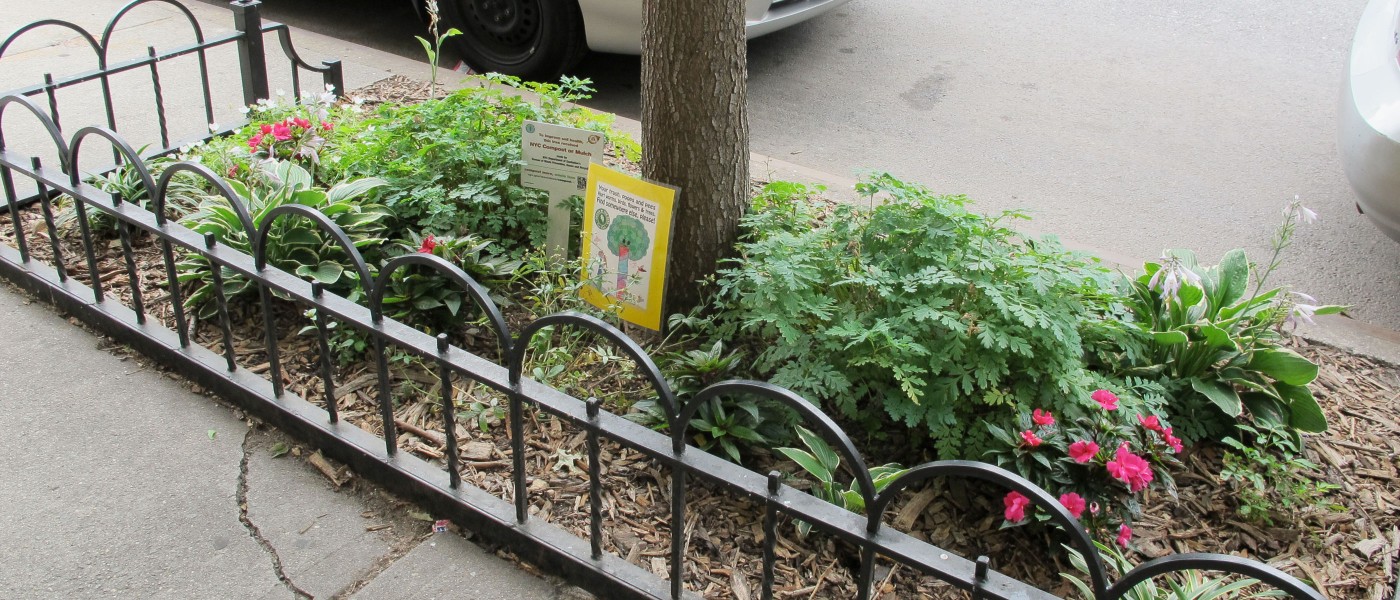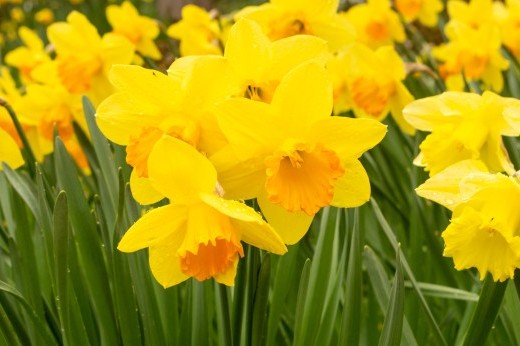In cities like Brooklyn, street trees play a huge role in supporting our shared environment. They sequester carbon, mitigate flooding, provide wildlife habitat, cool our neighborhoods, cleanse our air, and act as one of our most accessible forms of greenspace.
But in return, they need our support. Street trees live tough lives! Relatively small beds limit their water uptake, and their soil often gets tightly compacted, making it hard for roots to get enough oxygen. Meanwhile, they’re exposed to all sorts of stressors, like trash, pollution, and road salts. Many street trees in New York City rely on volunteers and local communities to care for them, and there’s a lot we can do to show these trees some love.
Every summer, the BBG Community Greening team hosts workshops to help Greenest Block in Brooklyn contestants brush up on their stewardship skills. Whether you’re a contestant, a budding tree care enthusiast, or just a curious neighbor, here are a few of our top tips to help you get started.
Stay Safe
One of the first things we urge people to do is to assess their surroundings. Look around and ask yourself, “Is there a lot of traffic near the tree bed that I plan to work in?” If so, you may want to wait for things to slow down.
You’ll also want to look up! Are there loose or precariously hanging tree limbs? If so, call 311 to bring attention to the hazard. Pay attention to what’s in the tree bed, too. Street tree beds tend to collect litter and other debris; you can protect yourself by putting on gloves before getting to work.
Water Wisely
Like any other plant, trees need water. A tree’s water needs depend on its age. Younger trees will need roughly 10–15 gallons of water each week, while more mature trees should receive 8–10 gallons.
Trees like to be watered slowly and steadily. The “bucket method” is one great way to do this. Drill a hole toward the bottom of a five-gallon bucket and cover the hole with duct tape. When you’re ready to water your tree, fill the bucket with water, place it in the tree bed, and peel back the duct tape flap.
The gentle stream of water will slowly water your tree. Be sure to move the bucket around the bed periodically so the tree gets evenly hydrated.
Care for Your Soil
Before you get to mulching or composting, take a moment to loosen compacted, dense-looking soil in your street tree bed. Gently work a hand cultivator back and forth on the top layer of the soil, taking care not to disturb any roots.
A quick tip for decompaction and aeration: Using an aerator tool (or an old screwdriver) and poking holes near the perimeter of tree beds is a handy way to get oxygen to tree roots. Be careful not to poke too close to the base of the tree, lest you puncture the roots themselves!
Adding compost to your tree bed can also help get important nutrients to trees, and aid in the decompaction of soil over time. A thin half-inch layer should be enough to benefit your tree.
Mulch is going to play another big part in keeping your tree bed healthy. Mulch is used in tree beds to moderate soil temperature, retain moisture, and suppress weeds. While mulching is important, be careful not to use too much! You’ll only need a two-to-three-inch layer; going beyond that can harm the tree.
It’s also important to leave an eight-to-ten-inch mulch-free space around the tree’s base. Doing this will prevent moisture from getting trapped under the mulch and rotting the tree bark.
When taking care of your tree bed, you may be tempted to add soil or use fertilizer. Although I understand the thought process, it’s best to avoid doing so. Fertilizers contain salts that are harmful to tree health, and adding more soil to your tree bed can damage tree roots by depriving them of oxygen.
Right Plant, Right Place
Once your tree is watered, composted, and mulched, you may be thinking about adding some plantings for an extra pop of color. If you do, try to be mindful of the plants you choose—the health of the tree should be the main priority of your tree bed.
Avoid planting anything that would compete with the tree for resources, such as shrubs and other woody plants. (If it has a woody stem, steer clear.) Also avoid climbing vines like English ivy. Some great herbaceous plants that can live harmoniously with trees include Rudbeckia, Monarda, and Heuchera species, as well as creeping jenny (Lysimachia nummularia), moss phlox (Phlox subulata), and common yarrow (Achillea millefolium).
For more suggestions, check out BBG gardener Laura Powell’s ideas for tough tree bed plants, as well as the NYC Parks Department’s latest recommendations for planting in tree pits.
Protect Your Tree
Installing a tree guard and putting up signs helps communicate to passersby that someone is actively looking after a tree bed, deterring litter as well as other waste. While tree guards and signs aren’t a fail-safe, they’re an important mitigation tool.
The NYC Parks Department offers some useful tips for accessing tree guards. In addition, homemade signs can be especially vital in reaching pet owners that may believe their furry companions are “fertilizing” tree beds! Animal waste is not helpful for trees, and friendly signs directing pet owners elsewhere can go a long way.
Above all, be sure to enjoy yourself—taking care of trees is a fulfilling way to connect with nature and your surrounding community. Thank you for making the time and effort to protect our urban forest.



